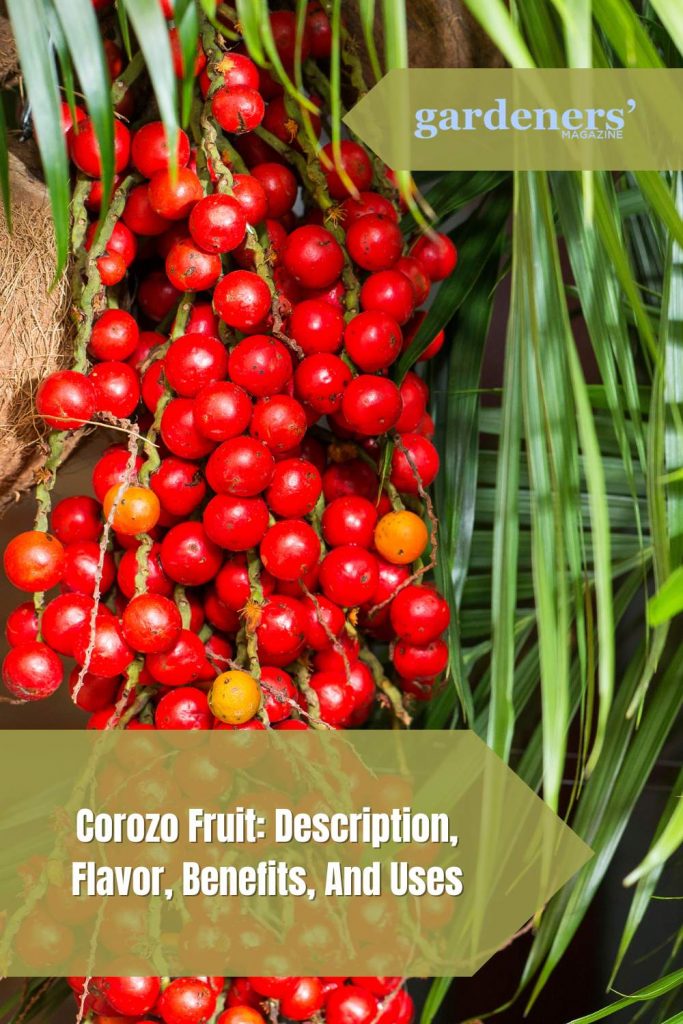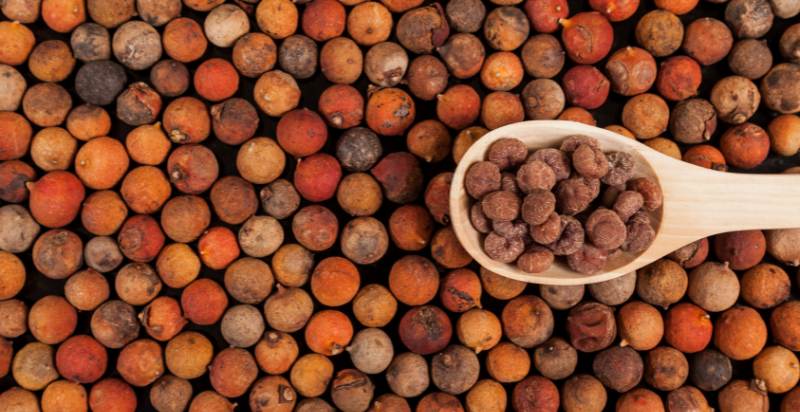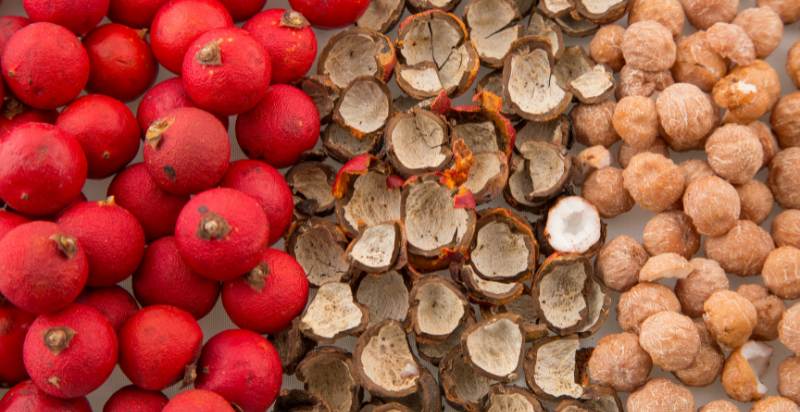The Corozo Fruit, aka the miracle fruit, is an exotic and nutritious fruit with many health benefits. This tropical plant has been used since ancient times for medicinal purposes, and today it is widely consumed as a food source in many parts of the world. The Corozo fruit is a great source of vitamins A, B1, and C and minerals like calcium, iron, magnesium, and zinc. It also contains powerful antioxidants that can help protect the body from free radical damage. Here is everything you need to know about Corozo fruit.
What is Corozo Fruit?
Corozo (moriche palm) is an edible fruit that grows in South American countries such as Venezuela, Colombia, and Brazil. It is a bright orange-yellow fruit that has a unique texture and flavor. It is usually eaten fresh but can also be used to make sweet dishes, liquors, syrups, jams, and sorbets. This fruit has a high nutritional content, making it an excellent source of vitamins, minerals, antioxidants, and dietary fiber. Additionally, its pulp contains plenty of healthy fatty acids that promote cardiovascular health.
Corozo is also known for its anti-inflammatory properties and can help to reduce inflammation in the body. Lastly, it helps to improve digestive health and has been linked to improved metabolic function. Therefore, it is not only a tasty snack but also one that can bring many health benefits.

History and Corozo Fruit
The Corozo fruit, also known as the tagua nut or vegetable ivory, is a type of palm tree endemic to the tropical forests of Central and South America. It has been used for centuries by indigenous people in the region as a source of food and nutrition. In addition to its culinary uses, it has long been appreciated for its potential value in various craft applications due to its hard and durable nature.
Corozo is a hard, ivory-like material that can be polished and carved into various shapes. It has been used for centuries as an alternative to animal ivory in manufacturing buttons, jewelry, combs, and other decorative items. It is especially prized for its ability to hold intricate details when carved.
Today, Corozo remains a popular material for craft applications and is increasingly used in producing fashion accessories. Its traditional uses continue to provide economic opportunities for local communities, while its modern applications are helping to conserve this natural resource. As more people become aware of its potential, Corozo’s sustainable use will surely grow in popularity.
Description of the Corozo Fruit
The Corozo Fruit is a tropical fruit that grows on the corozo palm tree. It has an oval-shaped body with thin greenish-yellow skin and fleshy white pulp. The size of the fruit depends on its variety; some varieties can reach up to 10 cm long and 6 cm wide, while others can be smaller. The meaty, creamy pulp of the Corozo Fruit is sweet and juicy with a mild flavor. It contains numerous small seeds that are edible and rich in nutrients.
Flavor Profile of Corozo Fruit
Compared to other fruits, Corozo Fruit is sweet with a subtle tartness and honey undertones. The texture of the fruit is similar to a mango, with firm and juicy flesh. The flavor of the fruit is unique and vibrant, making it a popular choice for those looking to add a sweet and tart flavor to their culinary creations. Its texture and flavor make it an ideal addition to salads, sauces, smoothies, desserts, and more. Corozo Fruit is also commonly used in cocktails to add a unique flavor and texture that can’t be replicated with any other fruit.
Health Benefits of the Corozo Fruit
The Corozo Fruit is a nutrient-packed superfood that can provide many health benefits. It is scientifically proven to be an excellent source of vitamins and minerals, with high levels of vitamins A, B6, C, and E. Additionally, Corozo contains a good amount of magnesium, zinc, and potassium.
Corozo has also been linked to numerous other health benefits, such as improved vision, healthy skin complexion, increased metabolism, and better digestion. It can also help reduce the risk of heart disease, stroke, and other chronic illnesses. Furthermore, Corozo can reduce inflammation in the body, making it a great choice for those suffering from arthritis or other inflammatory conditions.
The antioxidant content of Corozo is thought to help protect cells from oxidative damage caused by free radicals. This can help prevent cancer and slow down the aging process. Additionally, studies have suggested that consuming this superfood can boost the immune system, improve mental clarity and reduce stress levels.

Cultivation of the Corozo Fruit
The Corozo fruit is a tropical plant native to South America. It can be grown in the home garden or commercially and is an excellent source of antioxidants that help protect against disease. The tree grows best in full sun and well-drained soils with a pH between 5.8 and 7.0. It should be planted at least 3 feet apart from other plants and trees, as it requires plenty of space for its large leaves and fruits to grow.
The young trees require frequent watering until established; they will need less water but should still be monitored closely for signs of drought stress. Fertilize every four months with a balanced 10-10-10 fertilizer and prune regularly to keep the canopy open and the tree healthy. The Corozo fruit ripens in late summer or early fall and can be harvested when it has a light orange hue. It is best enjoyed fresh but can also be frozen later.
Harvesting of the Corozo Fruit
Harvesting of Corozo fruit is fairly simple and can be done by hand. Once they rip, the fruits are picked off the trees with long sticks or poles. It is important to ensure that all unripe or damaged fruits are left on the tree to not interfere with future harvests. The harvested fruits should be placed in baskets lined with leaves and transported for processing.
During this process, it is important to protect the fruit from any damage, such as scraping or bruising, as this could affect its quality and shelf-life. After harvesting, the Corozo fruits must go through peeling and deseeding before being used for consumption. Finally, make sure that only ripe and healthy fruits are used for harvesting. This will ensure that the best quality products are obtained.
Where do Corozo Fruit grow region-wise?
Corozo fruit is widely grown in the tropical regions of Central and South America and the Caribbean. It’s typically found in Mexico, Colombia, Ecuador, Peru, Bolivia, Honduras, Guatemala, and Costa Rica. Other countries that produce Corozo include Panama, Venezuela, Nicaragua, and El Salvador. It is also known as Tagua or Palma de Cera (wax palm) in Colombia. The fruit is also grown commercially on a smaller scale in Hawaii and Puerto Rico.
What must you remember when buying Corozo Fruit?
When buying Corozo fruit, look for the ones that are bright orange and slightly firm to the touch. Avoid fruits with soft spots or discoloration, as they may be overripe or damaged. Also, ensure that there is no excessive bruising on the fruits, as this could indicate mishandling during harvest or transportation. It is also important to choose heavy fruits for their size, as this indicates a higher level of juiciness. Finally, inspect the skin of the Corozo fruit for any blemishes or imperfections, as this could compromise its quality and nutritional value.
That being said, buying Corozo fruit can be an exciting experience. With a bit of research and careful selection, you can enjoy all its delicious benefits.
What is the best way to Store Corozo Fruit?
The best way to store Corozo Fruit is in a cool, dry place away from direct sunlight. When storing the fruits, make sure they are clean and dry. Keep the fruit away from other fresh produce as it can easily absorb the odors and flavors of other foods. Also, please keep them in a well-ventilated area to prevent spoilage from moisture buildup inside the fruits. It is recommended that the fruit should be consumed within one week after purchase; otherwise, it should be stored in an airtight container in the refrigerator for up to two weeks.
For longer-term storage, you can freeze the Corozo Fruits by wrapping them individually in plastic bags or containers before placing them into the freezer. This will help maintain their flavor and texture for up to six months.
It is important to remember that Corozo Fruits are susceptible to damage from extreme temperatures, so keeping them in a cool and humid environment is best. Remember these points while storing your Corozo Fruits so that you can enjoy their delicious taste every time!

How can Corozo Fruit be used in recipes with other fruits and vegetables?
Corozo fruit can be used in various sweet and savory recipes that involve other fruits and vegetables. Many enjoy blending Corozo with bananas to make a smoothie or add it to a salad. It also makes an excellent addition to salsas and sauces for fish or chicken.
Additionally, its sweet flavor pairs well with other tropical fruits like mangoes, papayas, pineapples, and limes in pies, ice creams, or desserts. Finally, its fleshy texture lends well to baking applications such as muffins or bread. Ultimately, the possibilities are endless for using Corozo fruit in recipes!
Conclusion
Corozo Fruits are a nutritious and delicious addition to any diet. They have a unique taste that can be used in both sweet and savory dishes. Storing them properly will ensure they stay fresh for longer, so you can continue to enjoy their flavor. Lastly, incorporating Corozo Fruit into recipes with other fruits and vegetables is an easy way to add variety and nutrition to your meals. With these tips, you can make the most of your Corozo Fruits.
- Everything You Wanted to Know About Red Tamarillos - June 2, 2025
- A Guide to Tulips: Everything You Need to Know & More… - June 2, 2025
- Guanabana: Description, Flavor, Benefits, And Uses - May 27, 2025

2 thoughts on “Corozo Fruit: Description, Flavor, Benefits, And Uses”
Comments are closed.